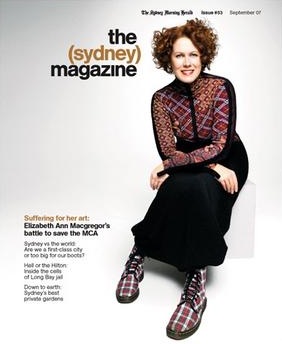The following article first appeared in Issue 53 of the(sydney)magazine, published in September 2007, and is Copyright ©2007 John Fairfax Publications Pty Ltd. Reproduction on whole or part is not permitted without written permission from the publisher.

In 1998, I boarded a plane and joined the "brain drain". I had travelled enough to know there weren't too many places where the quality of life could be better than Sydney. But my ambition was to do world-beating scientific research and I knew this would mean working overseas, building networks and broadening my skills.
For eight years I lived and worked in Boston, where I mixed with the world's best astronomers at the Massachusetts Institute of Technology (MIT) and at Harvard University. It was hard not to feel guilty that these foreign institutions were the ones getting all the benefits of my Australian training.
But the reality is that it's a huge credit to our educational system that so many of our graduates land premier positions in the world. Lord Bob May was until recently President of the Royal Society (past presidents include Sir Christopher Wren and Sir Isaac Newton); David Mackay and John Bryant are the CEO and CFO, respectively, of Kellogg Company; and Rodney Brooks has just stepped down as director of MIT's world-famous artificial intelligence lab to run iRobot Corporation.
We should be thrilled that so many of our best have what it takes to succeed at the highest levels. But why do so many of these talented people invariably end up moving - and staying - overseas? A quick look around suggests that our city puts a lot less public emphasis on science and innovation than might be found elsewhere. When colleagues ask what inspired me to become a scientist, I can share my fond childhood memories of the skeletons and astronauts at the Technological Museum in Harris Street. But that has now crossed the road and become the Powerhouse - an impressive institution but one whose mission has drifted into design and culture.
I can't help but contrast this with my many years living in Boston, a city that offers a smorgasbord of monuments to innovation: the iconic Museum of Science that dominates the skyline; the Boston Children's Museum, where I spent many wintry weekends helping my young son learn and explore; and the quirky MIT Museum, with its massive collection of holograms and robots.
In 2006, I moved back to Sydney. My Australian friends still at Harvard remind me that I've walked away from a town where world leaders regularly pass through to give lunchtime talks. They tell me that I've returned to a lightweight intellectual environment, where everyone knocks off for a drink at 5pm.
But Sydney is starting to move beyond its reputation as an intellectual
backwater. Our investments in education and excellence are finally beginning
to bring returns. No one might be more a poster child for the brain drain -
and brain return - than Professor
Jill Trewhella, who received degrees from
UNSW and the University of Sydney, but moved to the US to take up a position
at Yale in 1980. When anthrax was unleashed on the US in 2001, it was
Trewhella - by then head of biosciences at Los Alamos National Laboratory -
who was responsible for personally briefing President Bush on the government
efforts to respond to these attacks. In 2005, Trewhella was enticed back to
the University of Sydney, where she is
using the Australian Nuclear Science &
Technology Organisation's new world-class nuclear reactor to study the
structure of the key molecules that make life possible.
Despite the warnings of my Harvard friends, I am finding that the staff and
students with whom I work are just as talented as those in Boston and the
research facilities on offer here are distinctly superior. Sydney might not
be Oxford, where everyone around the dinner table is guaranteed to have a
PhD, and Sydney can't be compared to Berkeley, where there are special
reserved parking spots for Nobel laureates. But increasingly mixed in with
the good living and the brilliant sunshine are brilliant minds, with
world-beating ideas.
Bryan Gaensler
This article is
Copyright ©2007 John Fairfax Publications Pty Ltd. Reproduction
on whole or part is not permitted without written permission from
the publisher.
Professor of Physics and Federation Fellow at the University of Sydney.
Last updated: 04-Sep-2007
Bryan Gaensler
bgaensler@dunlap.utoronto.ca